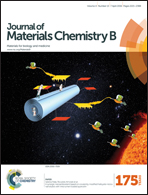Amino acid side chains affect the bioactivity of designed short peptide amphiphiles†
Abstract
The artificially designed amphiphilic peptide G(IIKK)3I-NH2 has been shown to be highly effective at killing bacteria and inhibiting the growth of tumor cells whilst remaining benign to normal mammalian cells. Herein we report how the side chain length and branching of constituent amino acids affect these bioactivities. Two peptide groups were designed by utilizing G(IIKK)3I-NH2 as the base template. In Group 1, hydrophobic residues were replaced from Ile to Leu, Nle (norleucine), or Val. It was found that an increase in the side chain carbon number from 3 (Val) to 4 (Leu, Ile or Nle) substantially enhanced their antibacterial and antitumor activities, but different branching in the butyl side chain showed very different cytotoxicities to host mammalian cells, with the γ-branching in Leu eliciting the highest potency. Group 2 covered those cationic Lys residues which were replaced by synthetic homologues with shorter side chains, namely, Orn, Dab and Dap containing 3, 2 and 1 methylene units, respectively. The replacement did not affect their antibacterial activities much, but their anticancer activities were maximized in Orn and Dab. On the other hand, their cytotoxicities also became higher, indicating a multi-faceted role played by the cationic residues. Thus, changes in both the side chain length and branching strongly affected the amphiphilicity of the short peptides and their interactions with different membranes. This work has revealed a strong relationship among side chain structures, amphiphilicity and selective bioactivities of the short peptide amphiphiles.


 Please wait while we load your content...
Please wait while we load your content...